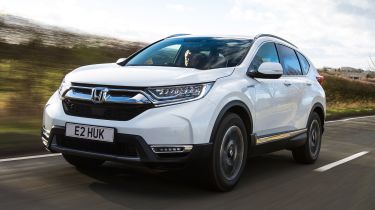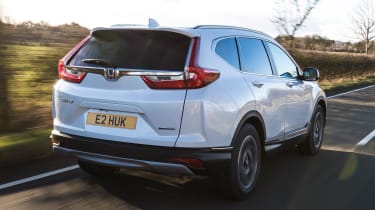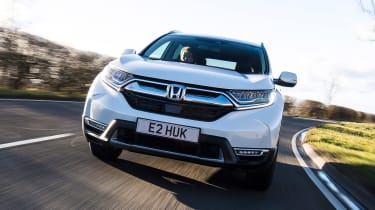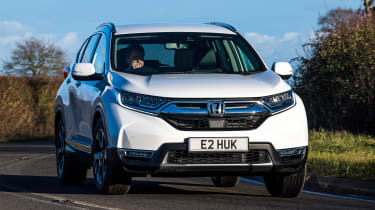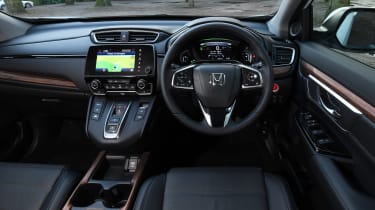Honda CR-V Hybrid
Clever fuel-saving technology makes the hybrid our favourite CR-V
Pros
- Good urban fuel economy
- Smooth to drive
- Quiet and well equipped
Cons
- Ungainly handling
- No seven-seat option
- No true diesel rival
Diesel’s fall from favour in the UK was behind Honda’s decision not to add a diesel model to the CR-V lineup when the current version was launched in 2017. Drivers in search of increased fuel economy and lower emissions are instead left with this petrol-electric hybrid version.
Other than the Toyota RAV4 hybrid and Kia Niro, there aren't many hybrid SUVs to choose from. This is set to change, with more car manufacturers pledging to introduce electrified versions of popular models. The big question, then, is whether the CR-V hybrid can fill the shoes of the diesel that's no longer offered.
The answer depends on how you expect to use your family SUV. Honda's claim of up to 40.9mpg is only just ahead of the 38.2mpg offered by the conventional 1.5-litre petrol CVT model.
However, it's when negotiating slow urban traffic that a hybrid is in its element; the electric motor is sufficient for low speeds, with the petrol engine only required when battery range is depleted or greater acceleration is required, extending its economy advantage. Out on the open road, though, the electric advantage starts to dwindle. On the motorway, the petrol engine will provide cruising power, with extra electric boost available for overtaking. At these speeds, though, you might not experience economy any greater than the conventional petrol version.
More reviews
It's fair to say, then, that its decision to discontinue the diesel CR-V leaves Honda's SUV range without a car that's economical for long distance journeys, and the Nissan Qashqai or Renault Kadjar might be a better bet if you spend all day on the motorway. However, if you make fewer long journeys than you do town-centre visits, the hybrid is our favourite CR-V.
Thanks to a unique Intelligent Multi Mode Drive (i-MMD) hybrid system that uses a 'motor/generator' in place of a conventional automatic gearbox, it essentially has no gears at all and is smoother and quieter to drive than the CR-V manual or CVT automatic. It's no slower, either, and contributes less to inner-city pollution than those models. That fact, incidentally, also gives it a lower 25% Benefit-in-Kind (BiK) tax rating for company-car users than the 29-33%-rated petrol versions.
A premium of around £1,000 over four-wheel-drive petrol automatic models seems quite reasonable for the hybrid, and only a slightly heavier feel in corners and a minor reduction in boot space counts against it. If you're looking for a family SUV that's especially at home around town, the CR-V hybrid should appear high on your shortlist.
MPG, running costs & CO2
Measured according to the latest WLTP techniques and then converted to allow comparisons with figures calculated under NEDC conditions, the CR-V hybrid returns a claimed 40.9mpg for the four-wheel drive version, and 38.2mpg for front-wheel drive models.
Note that official fuel economy tests favour hybrid vehicles – they can tackle much of the low-speed running that makes up the test cycle with little call for the petrol engine to come to life. Peak economy will only be delivered when a hybrid is running in its pure EV and hybrid modes, and fuel consumption will increase dramatically when Engine Drive mode is selected. With a very small 1kWh battery pack, Honda offers no specific figure for all-electric range.
Bear in mind the conventional CR-V petrol is claimed to return up to 38.2mpg and don’t be surprised if the hybrid's fuel consumption drops to a similar level on longer journeys when the EV mode is seldom usable.
Honda's clever Intelligent Multi Mode Drive (i-MMD) can be locked into either of its three driving modes, or you can leave it to work out the most efficient settings by itself.
While a hybrid's actual fuel consumption will vary depending on how it's driven, its CO2 emissions figure – the rating from which Benefit-in-Kind (BiK) company car tax is derived – is set in stone. Irrespective of the journeys it makes, you'll pay a lower 25% rate of BiK for the hybrid, compared to 31% for four-wheel drive CVT automatic versions.
Other CR-V hybrid running costs are likely to be comparable with other models in the range, with routine servicing little more expensive than the Honda Civic hatchback. Honda's service plans will help you contain the costs of regular maintenance.
Engines, drive & performance
The hybrid CR-V uses a 2.0-litre i-VTEC petrol engine and a lithium-ion battery pack that sends electricity to a powerful electric motor. While hybrid systems like that of the Toyota Prius use a CVT automatic gearbox, Honda's clever intelligent Multi-Mode Drive (i-MMD) setup uses a 'motor/generator' in its place. The claimed result is greater efficiency and increased smoothness. Over the course of our drive, it certainly proved less frustrating than the CVT gearbox fitted to the conventional CR-V petrol, as well as being noticeably quieter.
There are three driving modes; Engine Drive, Hybrid Drive and EV Drive, with decreasing reliance on petrol power. When Engine Drive is engaged, the motor-generator and electric motor are locked to provide a direct mechanical drive from the petrol engine to the front wheels – typically at high motorway speeds. In Hybrid Drive mode, the petrol engine turns the motor-generator but is disconnected from the wheels. Instead, electricity generated is sent to the electric drive motor as well as topping up the battery. EV Drive, meanwhile, uses the battery alone to power the car for short distances. Honda claims that clever software allows the hybrid to switch between the power modes almost seamlessly, and this seemed to be the case on our test.
Total system power is 181bhp, and while the hybrid's 0-62mph time of 8.8 seconds won't break any speed records, an absence of gearchanges – the starter-generator effectively acts as a single-speed gearbox – makes for very smooth acceleration. Enthusiastic drivers will note the steering wheel paddles, but these are used to adjust how energy is recuperated from the motor-generator and regenerative braking system, rather than to make manual gear changes. There’s a 'sport' mode that is claimed to offer a sharper throttle response, but we barely noticed any difference.
No Honda CR-V is in its element on a country lane, and the hybrid adds a further 100kg to the SUV's already bulky frame, with additional body lean as a result. However, the steering is sharp and precise.
Interior & comfort
Step into a CR-V hybrid and you'll notice little difference inside from regular petrol-powered versions. The gear selector is gone, with drive mode selection buttons in its place, and there's a digital dashboard that provides information on fuel economy, driving mode and battery range, but the layout is generally the same as any other CR-V.
That's no bad thing – the CR-V has an attractive and well-ordered dashboard that favours common sense over sheer style, and many will prefer its conventional layout to the more idiosyncratic Peugeot 3008 and Citroen C5 Aircross. Materials used are, for the most part, of high quality, but the glovebox lid and door bins feel a little cheaper than more prominent areas of the dashboard.
Where you unquestionably will find a pleasing difference between the CR-V hybrid and other versions, is in its lower noise level. This is especially the case when nipping about town in EV Drive mode, but the absence of a traditional gearbox means engines revs don’t soar as often as they do in CVT-equipped petrol models – this only really happens when you put your foot down for maximum acceleration. The hybrid rides at least as smoothly as petrol versions, too. The CR-V hybrid rides well and soaks up the road nicely, delivering comfort to match the serene environment.
You can choose the hybrid in the same S, SE, SR and EX trim levels as are offered with the petrol engine, and all models have the Honda SENSING package of driver aids. This includes Autonomous Emergency Braking (AEB), forward collision warning, lane keeping assist and lane departure warning, adaptive cruise control and traffic sign recognition.
Practicality & boot space
The biggest difference between the hybrid and petrol CR-Vs as far as family life is concerned, is that the former comes without a seven-seat option. In truth, the CR-V's third row of seats is only suitable for occasional use by very small children anyway, and we think it too cramped to afford the CR-V genuine seven-seat status.
Seven seats is not available as an option in the hybrid due to the space required to accomodate the lithium-ion battery pack, which is situated beneath the boot floor and also serves to reduce luggage capacity from 561 to 497 litres. Even the reduced figure still comes close to matching the 520-litre Peugeot 3008, and you still get a flat loading bay and the option to enlarge the boot when the rear seats aren't required.
Elsewhere, the CR-V hybrid is just as accommodating as any other version, with loads of space for front and rear seat occupants and an uncluttered floor that means even the centre rear seat passenger has somewhere to place their feet. The driving position is set high, too, with excellent visibility that makes it surprisingly easy to thread the CR-V through narrow urban roads.
Reliability & safety
In recent years, Honda has performed extremely well in our annual Driver Power owner satisfaction survey. It came third overall out of 16 brands in 2018, with high scores for economy, quality, practicality and reliability all contributing to its success.
The latest generation of Honda CR-V has yet to be ranked in Driver Power, but its predecessor was much liked. In our 2018 survey, the CR-V came 12th overall out of 75 cars, with owners praising the car's engines, style, comfort, practicality, ride and running costs. Its quality and reliability were particularly appreciated, too, although 11.3% of owners reported at least one fault in the first year of ownership.
That model was discontinued in 2017 but today's ought to build on this reputation and also has several of Honda's latest advances in technology, particularly in terms of safety, which is one area in which owners reckon the previous model could have done better. Today's model has yet to face independent crash testing by EuroNCAP but it's certainly not short on safety kit.
The brand's SENSING package of driver-assistance features is standard across the range, and brings autonomous emergency braking (AEB) and lane departure warning to mitigate the likelihood of a crash, while active cruise control and lane keeping assist helps to reduce driver workload.
Price, value for money & options
Honda tends not to offer a lengthy options list, aiming to offer trim levels sufficiently equipped to meet individual customer demand. You can, however, add an Aero pack and a Premium pack; the former is a body kit that adds sporty style to the front and rear bumpers and side skirts, while the Premium pack does a similar thing but with the emphasis on practicality rather than sportiness – you'll find mud-flaps and body trim in textured black rather than glossy body colour.
When it comes to rivals, the CR-V Hybrid only faces direct challenge from the Toyota RAV4 hybrid and its more stylish Toyota C-HR stablemate. While the Kia Niro is arguably a rival, it's more SUV in style than feel and versatility, and offers no four-wheel drive option. Those who make a lot of runs into town, or who cover fewer than 12,000 miles every year, won't regret choosing either of these models.
As we've seen, hybrid SUVs bring financial advantages for those who pay Benefit-in-Kind (BiK) company car tax, especially if somebody else foots the petrol bill. However, if BiK isn't an issue to you but fuel consumption definitely is, you'll probably find a diesel better suited to your needs, and Honda's decision not to offer one opens the door to European rivals such as the Skoda Karoq, SEAT Ateca, Peugeot 3008 and Renault Kadjar.

